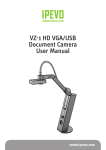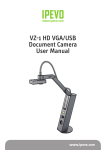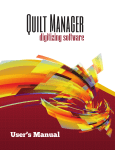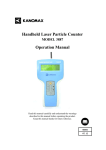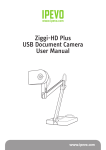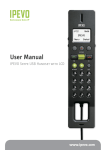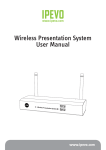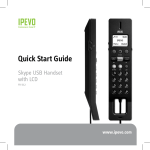Download Ziggi USB Document Camera User Manual
Transcript
Ziggi USB Document Camera User Manual www.ipevo.com 6. freeREC Table of Contents Introduction 4 What Makes Ziggi Different? 4 Versatility 4 High-Quality Capture 4 Effortless Autofocus 4 Feature-Rich P2V Software 4 Contents 5 About the Packaging 5 Getting Help 6 Version Information 7 System Requirements 8 Installation 8 Getting to Know Ziggi (Key Features) 9 P2V Software Introduction Switching between software modes 10 10 Basics of the P2V Software Camera mode Full Screen mode Review mode Getting a Great Image – Five Considerations 13 Image Size Zoom function Capturing a Standard Sheet of Paper 14 14 14 Image Orientation Landscape versus Portrait Camera lens orientation 15 15 15 Changing Orientation Swivel head Mirroring function 16 16 16 Exposure Exposure Value (EXP) toggle Exposure tab Auto exposure Stop-motion animation 17 17 17 18 18 Focus Autofocus switch Continuous and Single focus modes Focus button 2 11 11 11 12 19 19 19 19 Table of Contents Resolution Changing resolution High-definition versus standard-definition Resolution and frame rate 20 20 20 20 Snapshots Taking a snapshot Timer function 21 21 21 Projecting Your Image Full Screen mode 22 22 Preparing Your Setup for Projection Mirroring your desktop 23 23 Advanced Settings Instant Preview Changing sound effects Photo library location Photo name format Keep camera mode settings Image adjustment customizations About P2V Setting a language Starting P2V when computer starts 24 24 24 24 24 24 25 25 25 25 Using Ziggi in Other Ways With Skype As a web/conferencing camera 26 26 26 Anti-Glare Shield 27 Closing and Exiting the P2V Software 28 Keyboard Shortcuts 28 Troubleshooting and FAQ 29 Safety Information 30 Acknowledgments 30 3 Introduction/What Makes Ziggi Different? Introduction Thank you for your purchase of the Ziggi USB Document Camera. The Ziggi is a multifunctional document camera for PC or Mac that provides effortless, high-quality video capture for documents, three-dimensional objects, and devices with digital screens such as smartphones and Apple’s iPad and iPad 2. The Ziggi offers features and functionality similar to document cameras costing hundreds or even thousands more, all in a compact and easy-to-use device. What Makes Ziggi Different? Versatility – Ziggi’s unique multi-jointed stand gives you the freedom to place the camera in a wide variety of positions without the hassle of tightening knobs or otherwise locking the stand. At all positions, Ziggi will remain secure and stable because of its weighted base, offering you on-the-fly customization of your image. The Ziggi stand can fully extend to capture an entire standard sheet of paper. High-Quality Capture – Ziggi features a 2 Megapixel camera, and can achieve a resolution of up to 1600 x 1200 pixels. This high-definition video capture provides a crisp, brilliant image. Additionally, Ziggi features a Macro mode, allowing for sharp focus on very close subjects up to 2 inches (5 cm) away. For these reasons, Ziggi is ideal for capturing minute details of documents and pictures. High resolution capture is also appropriate for large-screen projections. Effortless Autofocus – Ziggi has a smart focusing system that gives you manual control when you need it and convenient automatic control when you don’t. Ziggi can be set to either of two focus settings: •Continuous Focus – in which Ziggi automatically and constantly determines the best focus. In this mode, you are free to move the subject around, and the focus will continue to stay sharp. •Single Focus – in which you set focus once, with Ziggi staying with that focus setting. This mode is best for a subject that will remain at the same distance from the camera, such as a static sheet of paper. Feature-Rich P2V Software – Included software provides a number of functions and customizations to get the most out of your Ziggi experience. Organizing snapshots, setting exposure levels, mirroring the incoming video, and Full Screen mode are just some of the features of this software. 4 6. freeREC/About the Packaging Contents Contents Your package should contain the following: • Ziggi camera unit, including multi-jointed stand • Anti-Glare Shield • CD-ROM with P2V software and user manual (in .pdf format) • Quick Start Guide Package Contents CD with P2V Software and User Manual Ziggi™ USB Document Camera Suitcase-style packaging Quick-start Guide Anti-glare Shield About the Packaging IPEVO has a longstanding commitment to green business practices, and this extends to our product packaging. We like our products to do the talking, not fancy packaging! Your Ziggi has been shipped with a minimum of packaging materials, particularly a minimum of plastic. The plain craft paper box (which does not contain high-resolution graphics or wasteful multi-color printing) is recyclable, as are the cardboard cut-outs keeping the Ziggi in place. 5 Getting Help Getting Help We want to help you enjoy your Ziggi, and we are always available to answer any questions or offer technical and troubleshooting assistance. Consider using one or more of these resources: •IPEVO.com – The latest versions of the Ziggi software, user manual, FAQ, and other downloads are available at this link: http://support.ipevo.com/#Ziggi •Email – Send us an email at [email protected] with your question or concern. For the best and most prompt service, include the version of your operating system with any inquiry, as well as a detailed explanation of the issue you are experiencing. •Phone – Customer service representatives are available to assist you Monday through Friday, from 8 a.m. until 4 p.m. Pacific Standard Time (PST). Our telephone number is 1 (408) 490 – 3085. •Live Chat – Live Chat is available through our website, www.ipevo.com. A button in the upper right-hand corner of the main page will take you to an Instant Messaging session in which you can correspond with a customer service representative directly. This feature is available during the same hours and days as our telephone support. •Help Link – Help, within the P2V software, will bring you to IPEVO’s website for the latest version of the software and other support and information. To access Help: Windows – Click on Help (the question mark icon) in the upper right-hand corner of the software. Macintosh –Select Help > Ziggi Help. 6 Viewing Your Software’s Version Viewing Your Software’s Version We recommend periodically checking IPEVO.com for the latest version of the P2V software. To determine the software version you are currently running, do one of the following: Windows – Right-click the Ziggi icon in the system taskbar, and click About. Macintosh – Select About > About Ziggi. You can also view the version information from the Advanced Settings window: Windows –Click Settings (the wrench icon) in the upper right-hand corner of the software screen, and select the System tab. Macintosh – Select Ziggi > Preferences, and select the System tab. 7 System Requirements/Installation System Requirements Ziggi requires a PC or Mac system with these minimum specifications: PC •Microsoft Window 7, Vista or XP •1.4GHz CPU or higher (2.4GHz recommended) •512MB RAM (1GB recommended) •200MB free hard disk space Mac •Mac OS X 10.5 or higher •1.4GHz CPU or higher (2.4GHz recommended) •512MB RAM (1G recommended) •200MB free hard disk space Installation PC •Insert the CD-ROM into your computer’s drive. Follow the prompts to complete the installation of the P2V software. A black and white Ziggi icon will appear in your taskbar, which can be used to open or close the software. Note: If the installation program does not automatically appear, you may navigate to the CD-ROM drive through Windows Explorer (often the D drive), open the Ziggi CD-ROM, and double-click “setup.exe” to run the installation. Mac •Insert the CD into your computer and activate the disk image file (*.dmg). Copy the P2V application file into the Applications directory. After installation, perform the following: 1. Connect the Ziggi’s USB cord to any open USB port on your computer. 2.Launch the P2V software. A screen containing a live video image from your Ziggi should appear. The Ziggi is now ready to use. Note to Point 2 View owners: If you have previously purchased IPEVO’s Point 2 View USB Document Camera, you may have an older version of the software installed on your system. You will need to uninstall this software prior to successful installation of the latest version of the P2V software. 8 Getting to Know Ziggi (Key Features) Getting to Know Ziggi Take some time to familiarize yourself with the key features of Ziggi: A –Stand Ziggi’s stand has three points of articulation with generous degrees of freedom, allowing you to place the camera by hand in any position, depending on subject and desired image size. Collapse the stand for compact portability. B –Base The weighted base provides a sturdy foundation for placing the camera in any position. C – USB Cord Inserted into any standard USB port, the cord powers the device and allows it to communicate with your computer. D – Camera lens Ziggi features a 2.0 Megapixel lens for detailed and vibrant images, allowing for a maximum resolution of 1600 x 1200. Ziggi has an automatic Macro mode for maintaining sharp focus on objects as close as 2 inches (5 cm) away. E – Swivel head In addition to the joints of the stand, you can further customize your image by swiveling the camera. 270° of swivel is possible – 180° clockwise and 90° counterclockwise. See Pages 15 and 16 for more on orientation. F – EXP +/- (Exposure Value) This toggle allows you to increase or decrease artificial exposure of the image, making it brighter (+) or darker (-). See Pages 17 and 18 for more on exposure. G – Autofocus (AF) switch Set your focus to one of two modes. Continuous (C) causes Ziggi to constantly determine the best focus for your image. Single (S) causes Ziggi to stay at a single focus. See Page 19 for more on focus. H – Focus button In Single focus mode, press this button for sharp focus of your subject. It takes a few seconds for Ziggi to determine and set proper focus. I – LED The LED gives you an easy way to know whether Ziggi is operating: white for operating, off for not. When you start the Ziggi software, the LED will light up. The LED has been positioned on the top of the camera so it will not reflect on any digital screens you might be capturing. J – Anti-Glare Shield If you are experiencing glare in your video capture, consider mounting the Anti-Glare Shield onto the camera. See Page 27 for more on the Anti-Glare Shield. C J E A F D B I G 9 H P2V Software Introduction The Ziggi software Specially-designed P2V software is included on your CD-ROM, and provides a rich suite of features to maximize your Ziggi use. Ziggi operates in one of three modes: •Camera mode – This is the default mode upon software startup. This mode shows the current video capture coming from the Ziggi camera. In this mode, you are also able to change aspects of the image such as exposure, mirroring, and resolution. See Pages 13 to get started with capturing your image. •Review mode – This mode gives you an easy way to review snapshots taken with your Ziggi. Snapshots are presented as thumbnail images in a row at the bottom of the screen. See Page 21 for more on taking snapshots. •Full Screen mode – In this mode, the image fills up the entire computer screen. Full screen is particularly useful when you need to project the Ziggi’s video for presentations. See Pages 22 and 23 for more on projecting your image. To switch between modes, click on the Mode Tab on the left-hand side of the capture window. Camera mode Review mode Full Screen mode The size of the window for Camera and Review modes can be changed by clicking and dragging on the edges of the window. 10 Basics of the P2V Software Basics of the P2V Software Please review the basic elements of the three modes of the P2V software: A – Mode Tab One of three modes can be selected by clicking on the appropriate button in the Mode Tab. B – Camera Menu Tab Several camera functions can be changed using the pulldown menus. These include: Zoom, Timer, Mirroring Mode, Resolution, and Exposure. This tab will also communicate the current settings of these functions. C – Snapshot Button Click the green camera icon to take a snapshot. See Page 21 for more on taking snapshots. D – Focus Button Click the rectangular crosshairs icon to focus the image. To the right of this icon, the software will tell you whether you are in Single or Continuous focus mode. E – Operations (Windows only) Here, you can access Advanced Settings (the Wrench icon), get Help (the Question Mark icon), minimize the capture window, or exit the capture window. F – ESC Button In Full Screen mode, hit “Esc” or click the ESC Button to exit Full Screen mode and return to Camera mode. E Camera mode Full Screen mode B A C D 11 F Basics of the P2V Software To review snapshots you’ve taken (see Page 20), enter Review mode by clicking on the “review” tab on the left-hand side of the software. A – Image Pane This shows the currently selected snapshot. B – Menu This gives you some basic tools to manipulate the selected snapshot. Zoom – Digitally zoom the image from 1x (normal, or no zoom) to 3x zoom. Rotate – Rotate the image left or right. Delete – Delete the selected image from your hard drive. The system will prompt you to ensure you want to delete the image. C – Folder Icon Clicking on the folder icon will take you to the location on your computer where your snapshots are stored. D – Image Information Provides information about the image, including file name, date taken, resolution taken at, and file size (in kilobytes). E – Thumbnail Timeline The snapshots you’ve taken are presented in a horizontal timeline of thumbnails. You can click on a thumbnail to select that snapshot, or you can use the arrow buttons to cycle through the snapshots. By right-clicking on a thumbnail, you can choose to Copy or Delete that snapshot, or open the folder it is contained in. Review mode B A C D E 12 Getting a Great Image – Five Considerations Getting a Great Image – Five Considerations When configuring the camera for your desired image, you will be chiefly concerned with the following five elements: •Image size - How large or small the subject appears in the frame (i.e. the window of the Ziggi software). When dealing with text, it is essential the text appears large enough for its intended audience to read. See Page 14. •Orientation – How the image is oriented relative to the frame. Naturally, it is necessary to present text in an upright, readable orientation. See Pages 15 and 16. •Exposure – Exposure is a measure of how much light is allowed to affect the image. Normally, you are seeking a medium exposure in which all the important details in the image can be viewed. Too little light will render a dark image that loses crucial details. On the other hand, too much light will result in a “blown-out” image that also loses detail. See Pages 17 and 18. •Focus – You will normally want your image to be sharp as opposed to blurry, which concerns focus. See Page 19. •Resolution – Resolution describes the amount of detail (information) an image holds. The P2V software allows you to change between several different resolutions. Higher resolutions communicate more detail, and are often necessary for large-screen projections. See Page 20. We will examine each of these five elements in turn. 13 Image Size Image Size For documents, your video capture is a balance between capturing as much of the document as possible, and making the text large enough on screen for your intended audience to read. Text size needs to be particularly large when the image is projected onto a screen for a group. There are a few ways to change the image size: •Change the position of the camera – Ziggi’s multi-jointed stand gives you a high degree of flexibility in camera placement. Alter any or all of the stand’s three points of articulation in order to optimally position the camera. Stand’s articulations presented in a couple positions •Change the position of the subject – When capturing a document, you will likely position it on the tabletop, on the same plane as your Ziggi base. When capturing close-up details or text passages from a document, you may find it handy to shift the document as you move from detail to detail, essentially scrolling through the text as necessary. Text document in one position under Ziggi with camera lens capturing top half of document, then moved “up” so that the camera lens is capturing the bottom half of document •Zoom – In the Camera mode of the P2V software, the Zoom tab allows you to digitally “zoom in” to your subject to make it appear bigger, anywhere from 1x (default, or no zoom) to 3x (or 3 times normal). 14 Image Orientation Image Orientation Two ways to describe page orientation come from the tradition of painting. Landscape refers to an image oriented so that its width is greater than its height, such as a classic landscape painting. Portrait orientation, on the other hand, features a height greater than its width, such as would be appropriate for a portrait painting. When deciding upon orientation, keep in mind whether the document to be captured is in landscape or portrait. You will need to control the orientation of your subject relative to the computer screen, so that the text is presented in a readable fashion. Illustration of Landscape versus Portrait Camera Lens Orientation The top of the Ziggi camera lens is located 90° counterclockwise from the square top of the camera body. With the camera head in its fully-extended position, documents will need to be placed perpendicular to the camera stand (as opposed to parallel) for text to be rendered “right side up” and readable on screen. The top of the Ziggi camera lens is located 90° counterclockwise from the square top of the camera body 15 Changing Orientation Changing Orientation You have several ways to change the orientation of your image: •Change the orientation of the document/subject – You may find it easiest to simply change the orientation of the subject you are capturing: 90° in either direction or turning 180° “upside down.” Before and After of changing the position of a document under Ziggi •Use the Swivel Head – Ziggi’s camera head is expressly designed to give you an easy way to alter orientation. From its fully-extended position, Ziggi can be swiveled 180° clockwise and 90° counterclockwise. Find the position that works best for yourself and your subject. For example, if you are giving a presentation and need access to the subject for a hands-on demonstration or to frequently change its position, you might consider moving the stand to one side of the subject—and changing orientation through the swivel head accordingly—so that the stand does not get in your way. Demonstrating swivel head and the degrees to which it can swivel •Mirroring – in the Camera mode, the Mirror tab allows you to flip the image horizontally, vertically, or both. Mirroring defaults to Off (no mirroring). “Horizontal” flips the image on a vertical axis going through the center of the image, while “Vertical” flips the image on a horizontal axis going through the center of the image. The tab will indicate H (Horizontal), V (Vertical), or H + V if both types of mirroring are being applied. No Mirror Set-up item to be captured Horizontal Mirror (H) Select the Mirror tab Vertical Mirror (V) 16 Horizontal + Vertical (H+V) Exposure Exposure Exposure refers to the amount of light allowed to hit the photographic medium—in this case, the sensor of the camera lens. In most circumstances, you will require a medium exposure allowing for the maximum amount of detail. Consider the following methods to achieve optimal exposure for your image: •Change the exposure in the room – This could include using a desk lamp near the Ziggi to shine additional light on the subject, turning on room lights, opening or closing curtains, etc. •Change the EXP (Exposure Value): Ziggi is able to artificially alter exposure on a fifteen-point scale, with 1 being the lowest (darkest) exposure value, and 15 being the highest (brightest) exposure value. 4 is the default value. If your image is too dark, consider increasing the EXP. Or, if your image is too bright, decrease the EXP. The EXP may be changed on either the camera body itself or via the software. Camera body: Use the EXP +/- toggle for on-the-fly exposure adjustments. The software will briefly indicate the change with an EXP number at the bottom of the image capture window, and your exposure will instantly change. S oftware: Click on the Exposure tab. You may either click on areas within the grayscale bar to change EXP, or drag the pointer to a value. Hitting “Default” will bring the exposure back to the default value of 4. Darker for Digital Devices S C Brighter for Printed Media AF 17 Exposure •Use Auto Exposure: As the name implies, auto exposure automatically changes exposure in order to maintain a medium, optimum exposure in which the maximum amount of details are shown. If lighting conditions in the room or on the subject are changing, or if the subject emits its own varying amount of light (as with an LCD screen), you might consider auto exposure. Automatic exposure adjustment depends upon two things: the EXP (Exposure Value, from 1 to 15), and the actual brightness/darkness of the subject. Exposure Value – Auto exposure with an EXP setting of 10 will always be brighter than auto exposure with an EXP setting of 4, for one example. Actual brightness/darkness – Auto exposure will react to changes in actual brightness/ darkness. With auto exposure on, if you are capturing a bright iPad screen and it dims, the Ziggi will adjust exposure to brighten the image. If the screen brightens again, Ziggi will adjust exposure to darken the image. •To Turn on Auto Exposure: Click the Auto tab in the P2V software, and select “On.” The sun icon next to Auto will turn green. Ziggi will now constantly determine the optimal exposure for your image, and may adjust exposure at any time. Note: Auto exposure should be turned to “Off” for stop-motion animation projects, which rely upon uniform, consistent exposure. 18 Focus Focus Focus refers to the convergence of light in your image. If your subject is “in focus,” light is properly converged at the right point. If your subject is “out of focus,” light has not properly converged at the right point. In most circumstances, you want your image to be sharp and in focus. Ziggi gives you a few tools to achieve proper focus, including the ability to automate focus for convenience. •Focus modes: Ziggi can be set to one of two focus modes using the Autofocus (AF) switch on the camera body. The software will indicate which focus mode you are in with either “Single” or “Continuous” under “AF” in the lower right-hand corner of the screen. C ontinuous (C) mode: In Continuous mode, Ziggi will constantly determine the best focus for your image and change its focal length accordingly. This is ideal for “set it and forget it” convenience, and also if the distance between the camera and the subject will be changing. For example, if you are showing the parts of a phone and are flipping the phone around in a hands-on demonstration, setting the Ziggi in Continuous mode will ensure your image is always in sharp focus. Single (S) mode: In Single mode, Ziggi will stay at a single focal length, and will not try to constantly adjust itself. This mode is ideal for manual control of focus. If you are capturing a text document laid on the table which is not moving, single mode will be sufficient for sharp focus. •Focus button: While the focus button is best for Single mode manual focus control, it will also work in Continuous mode. There are two focus buttons: the physical button on the camera body, and the fourcornered “crosshair” icon in the lower right-hand corner of the software. In either case, Ziggi will find the optimum focus. Focusing When focusing, four corners of a red box will appear in the center of the screen and a beep will sound, letting you know Ziggi is attempting to focus. The image may appear to slightly zoom in and out. When Ziggi is done focusing, the red corners will change to green corners, and there will be two quick beeps. For disabling the beep sound effects, see Page 24, Advanced Settings. 19 Resolution Resolution Resolution describes the amount of detail (information) an image holds. High resolutions relay more information (and therefore more detail), and also consume more computing power. Low resolutions communicate less detail, but are also less demanding of computer resources. Resolution is measured in pixels, the smallest part of a picture element. Changing Resolution To change resolution, click on the Resolution tab in Camera mode. There are six different resolutions to choose from, ranging from 1600 x 1200 pixels (the highest resolution) to 320 x 240 pixels (the lowest resolution). As 1280 x 720 resolution (and above) is commonly accepted to be “high-definition” (HD), the top two resolutions—1600 x 1200 and 1280 x 1024—are HD resolutions, while the four lower resolutions are standard-definition (SD) resolutions. Resolution and Frame Rate Generally, as resolution increases, frame rate decreases. Frame rate is a measure of how many distinct images are captured in a single second to make up the full-motion video perceived. Depending on your computer power, high resolutions may result in a low frame rate, and consequently a “stuttering,” “blurring,” or “strobing” of moving subjects, such as with a hands-on demonstration. If you find the amount of strobing to be unacceptable on your current resolution, consider lowering the resolution, which will increase frame rate and reduce or eliminate strobing. 20 Snapshots Snapshots Ziggi has the ability to take snapshots, still images extracted from the current video capture. Ziggi saves these snapshots, in .jpg format, onto your computer’s hard drive. Taking a snapshot is simple, and can be done in one of two ways: 1. Hit the “Enter” (Windows) or “Return” (Macintosh) key while using the P2V software in Camera mode. 2. Click the green camera icon in the lower right-hand corner of Camera mode. Taking a Snapshot Once you take a snapshot, the screen will briefly go black, accompanied by a classic shutter sound effect, and then your snapshot will appear on screen in an Instant Preview. After another brief period of black, the video capture function will resume. For changing or disabling Instant Preview, and for disabling the shutter sound effect, see Page 24, Advanced Settings. Using the Timer Function The Timer provides a delay (in seconds) between the time you press the Snapshot button, and the time when Ziggi actually takes the snapshot. You might find this delay necessary to avoid any shake in the camera body that could result in a blurry image. Using the Timer eliminates this possibility. When using the timer, a countdown will appear on screen, with beeps for each second. The Timer, located in the Camera mode tab, can be set to either 3 seconds or 10 seconds. By default, the Timer is set to Off. To review snapshots, enter Review mode. See Page 12. 21 Projecting Your Image Projecting Your Image Ziggi’s image quality and high resolution are perfect for large-screen projections in the classroom or conference room. In general, you’ll need Ziggi, your PC or Mac, and a separate projector device (not included, sold separately). In most cases, Full Screen mode is preferred for projection. To enter Full Screen mode, click on the “full screen” tab on the left-hand side of the software. Full Screen mode will give you the same functions available in Camera mode. To exit Full Screen mode, press the Esc key, or click the “Esc” button in the upper right-hand section of the screen. 22 Preparing Your Setup for Projection Preparing for Projection You’ll need to mirror the content on your desktop (that is, the full screen of Ziggi’s video capture) and redirect it to your projector device. Please refer to your projector documentation for information specific to your projector. The process of mirroring depends upon your operating system. Here are general guidelines for how to accomplish desktop mirroring in each operating system: Mac OS 1. Open “System Preferences.” 2. Click “Display.” Set both displays to the same resolution. 3. Click the “Arrangement” tab to click mirroring mode on or off. 4. On MacBooks and some other Macs, mirroring mode can be toggled simply with the F7 key. Windows XP 1. Right-click the desktop, and click “Properties.” 2. In the dialog box, click the “Settings” tab. 3. Click the “Display” list, and you should see the Projector model listed as an alternate display option. 4. Select the projector, then click the option to “Extend my Windows desktop onto this monitor.” Windows Vista Windows Vista will often automatically detect the projector and default into mirroring mode. If Windows can’t identify the monitor, you can use Windows Mobility Center (available on mobile PCs) to connect the display: 1. Click the “Start” button. 2. Click “Control Panel.” 3. Click “Mobile PC,” and then click “Windows Mobility Center.” 4.On the “External Display” tile, you can click “Connect display.” There will be a “New Display Detected” dialog box. Press “OK” to connect the display. Windows 7 1.Windows 7 will pop up a display dialog box when you plug in the projector, with the title “Change the appearance of your displays.” 2.The second set of options from the bottom is called “Multiple displays.” Select “Duplicate these displays” to make the projector show your desktop. Note: Many classrooms and conference rooms have dedicated consoles for facilitating projection. Please refer to your IT department for specific instructions. 23 Advanced Settings Advanced Settings There are a number of advanced settings available to you to further customize the Ziggi experience. PC: In the upper right-hand corner of the P2V software screen, along with the usual minimize and exit functions, there is a Help link (the question mark), which leads to the IPEVO.com website, and a settings link (the wrench), which leads to advanced settings. Mac: Select Ziggi > Preferences. General tab Select Video Device – This should be set to “IPEVO Ziggi” •Instant Preview – This sets the preview for snapshots taken. The default value is 2 seconds – that is, after taking a snapshot, the software shows the snapshot you have taken for 2 seconds before reverting back to video. You can set this value to 4 seconds, 2 seconds, or Off. •Sound Effect on – By default, there are beep sounds associated with focusing Ziggi, and shutter sounds associated with taking snapshots. To disable either or both of these sounds, uncheck the boxes. •Photo Library Location – This controls where your snapshots are stored on your hard drive. Click “Change” to locate a new location where you’d like to store your snapshots. •Photo Name Format – By default, your snapshots are saved in a “YYYY-MM-DD_4-digit” format: year, month, day, and then a unique four-digit number. You can change the prefix before the unique four digits by clicking the second option and entering in your desired prefix. •Keep Camera Mode Settings – Each time the P2V software starts up, it will use the default configuration. To disable this, click “Yes.” The P2V software will now keep your custom settings between uses. Note: Regardless of the selections in “Keep Camera Mode Settings,” the P2V software will memorize all advanced settings. 24 Advanced Settings Image Adjustment tab The image adjustment tab provides a number of customizations relating to video image quality. Brightness (0 to 255) – controls lightness or darkness Contrast (0 to 31) – controls difference in color and brightness between different parts of the image Gamma (0 to 127) – Gamma correction, affects gray levels and how the image is reproduced on the screen Saturation (0 to 31) – controls the color saturation. Setting this value to 0 will result in a black and white image, while a value of 31 will result in very saturated, rich colors Hue (-180 to 180) – affects reproduction of color information Sharpness (0 to 15) – controls perceived sharpness/blurriness The Default button changes the above customizations to their default values. Note: Image qualities of snapshots cannot be altered (at least not in the P2V software). You must change these settings prior to taking snapshots. System tab •About P2V – This section displays the software version currently in use. A “Check for updates” link is available, which will take you to the IPEVO website in order to check for the latest version. •Language – Switch between English, Traditional Chinese, and Japanese. •Start P2V when computer starts – If you click “Yes,” the P2V software will start upon system startup. If “No,” you will need to manually start the software. 25 Using Ziggi in Other Ways Using Ziggi in Other Ways While Ziggi is designed as a document camera, it can also be used as a web camera/conferencing camera with Skype and many other applications. Ziggi’s top section can be rotated up, such that the camera is pointing horizontally rather than down. You may need to exit the P2V software prior to using Ziggi in other applications. Other applications have varying methods for how they detect and utilize cameras. Please refer to the Help documentation for these applications for specific instructions. When using Ziggi for video conferencing, ensure the Autofocus switch is set to Continuous mode. This ensures constant sharp focus. Note: we cannot guarantee that all the functions of Ziggi, including exposure and focus, will work predictably in other applications, and IPEVO cannot offer troubleshooting for applications outside the P2V software. 26 Anti-Glare Shield Using the Anti-Glare Shield You may experience undesirable glare in your image from reflected light. Possible sources of reflected light include overhead lights or a desk lamp directed at the subject. To reduce or eliminate this glare, Ziggi comes with an Anti-Glare Shield. Mounting the Anti-Glare Shield To mount the Anti-Glare Shield, align the grooves on the underside of the shield with the sides of the camera head. Slide the grooves into place, ensuring they lock into the sides of the head. When fully mounted, the hole in the Shield should align with the camera lens, so that the camera’s view is not partially blocked. 27 Closing and Exiting the P2V Software/Keyboard Shortcuts Closing and Exiting the P2V Software To close the P2V software: Windows – Click the Close button at the top right-hand corner of the window, or press Alt + F4 while the software is active. Macintosh – Click the Close button at the top left-hand corner of the window, or press Command + W. Closing the software does not exit it entirely. To exit the P2V application: Windows – Right-click the Ziggi taskbar icon, and select Close. Macintosh – Select Ziggi > Quit Ziggi, or press the Command + Q quit shortcut. Keyboard Shortcuts Here is a list of keyboard shortcuts which may facilitate your use of Ziggi: Function Mode Windows Mac Take snapshot All Enter Return Close window Camera/Review Alt + F4 Command+ W Close application All ---- Command+ Q Cancel Full Screen mode Full Screen Esc Esc Zoom in Review + / forward scroll + / forward scroll Zoom out Review - / backward scroll - / backward scroll Copy photo Review Ctrl + C Command + C Delete photo Review Del Del / Command + Del Switch to previous photo Review Switch to next photo Review Select all photos Review Ctrl + A Command + A 28 Troubleshooting and FAQ bleshooting and FAQ Ziggi will not turn on. Ensure Ziggi is plugged in to your computer with the USB cord. Ensure the P2V software from the CD-ROM is installed and running. Unplug the camera, exit the software, restart the software, and replug in the camera. There is a setting change I don’t want that I can’t get rid of. Access the Advanced Settings, and click No on “Keep Camera Mode Settings.” Then, exit and restart the application. The image is too dark/too bright. Adjust the exposure. See Pages 17 and 18 for techniques. The image is out of focus or pixelated. Press the focus button to bring the subject into sharp focus. See Page 19 for focus techniques. Increase resolution for an image with more picture information. See Page 20. The brightness of the image constantly seems to fluctuate. Automatic exposure might be on, in which Ziggi constantly adjusts for optimum brightness level. Disable Automatic exposure. See Page 18. Anything that moves on screen is very blurry and choppy. Decrease resolution so that frame rate increases for smoother movement. See Page 20. Can I record video with Ziggi? Ziggi does not have the capability to record video. There are several third-party applications that may be used in conjunction with Ziggi to record video. IPEVO cannot offer technical assistance for these third-party applications. Does Ziggi capture audio? No, Ziggi does not have a microphone. All my snapshots come out blurry. Enable Continuous mode to ensure the image is in sharp focus. Hit the Focus button to achieve sharp focus. Turn the Timer on so that camera shake does not contribute to a blurry image. See Page 21. The focus beeps are annoying! Disable sound effects in Advanced Settings under “Sound Effect on.” See Page 24. 29 Safety Information Safety Information For your safety and for the best performance of your Ziggi USB Document Camera: •Keep Ziggi from coming into contact with heat sources such as radiators, stoves, and hot laptops. •Do not immerse Ziggi in liquids, and protect it from moisture. •Supervise children using Ziggi. This device complies with Part 15 of the FCC Rules. Operation is subject to the following two conditions: (1) this device may not cause harmful interference, and (2) this device must accept any interference received, including interference that may cause undesired operation. Acknowledgments •“Windows” and “Skype” are registered trademarks of Microsoft Corporation, registered in the US and other countries. •“Mac” and “Macintosh” are registered trademarks of Apple Computer, Inc., registered in the US and other countries. © 2011 IPEVO Inc. All rights reserved. IPEVO, Point 2 View, the IPEVO logo, and other IPEVO marks are owned by IPEVO Inc. and may be registered. All other trademarks are the property of their respective owners. All screen images are either simulated or properties of IPEVO Inc. Customer Service (International) Email: [email protected] Tel: +886-2-5550-8686 Customer Service (USA) Email: [email protected] Tel: 1 (408) 490 – 3085 GO! http://www.ipevo.com































